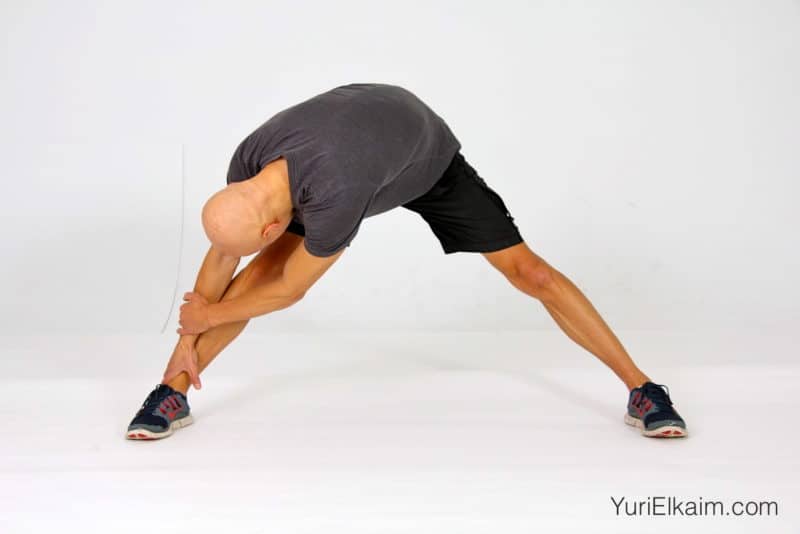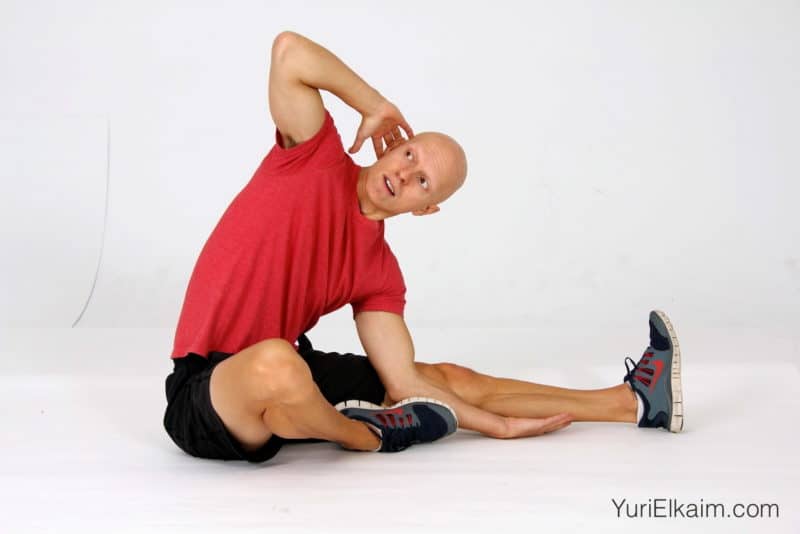If you’re like me and have hamstrings that are tighter than guitar strings, then these 3 stretches for tight hamstrings will do your body good and bring some much needed flexibility back to your body.
In this article

As a general rule of thumb, for improved flexibility, you want to stretch your muscles on a daily basis. When combined with regular movement, some good old fascial release (as you’ll see in the video below), and an alkaline diet, you’ll be amazed at how good your hamstrings and the rest of your muscles will feel.
However, in many cases stretching alone will probably not be enough to keep your hamstrings in tip-top shape. I’ll show what you do instead at the end of this article.
Never Stretch Without Doing This First
Your muscles are like elastic bands—they need to be warm to be as supple as possible. Therefore, be sure to do a proper warm-up before you think about stretching those “hammies” or any other muscles.
However, if you’re sitting in a sauna, taking a hot shower, or doing a hot yoga class, know that these hot environments provide sufficient warmth for your muscles by themselves and thus a normal active warm-up isn’t necessarily required.
But in general, you’ll want to warm your muscles up before stretching them. So whether that’s through active movement or after taking a warm bath or shower, doesn’t really matter. You just want them warm, so they’re more elastic when stretching. Cool?
Also, if you’re performing these stretches around your workout, do them AFTER your workout. Only dynamic exercises like these should be done before a workout. After your workout, or on its own, is when you’ll get the best results from stretching.
3 Easy Stretches for Tight Hamstrings
1. Supine “Active” Leg Extension

This is a great hamstring stretch because it forces “reciprocal inhibition” to come into play. Basically, what that means is that in order for your leg to stay straight, your quadriceps muscles must contract. In doing so, your hamstrings must relax since two opposing muscles cannot contract at the same time.
How to do it:
- Extend one leg, contract your quad, and hold for 5 second
- Return to starting position and repeat with the other leg.
- Perform 5 reps on each leg.
- Next, straighten one leg and hold, while contracting your quad.
2. Split Grab and Hold

This is an old “goalie” stretch I used to do while playing soccer.
How to do it:
- Start by standing tall with your feet shoulder-width apart.
- Step one foot forward and slide the other foot backward, as far apart as you comfortably can. Try to keep your feet in alignment with your hips, and your toes pointing forward. You’re aiming to get into a split position.
- Slowly lower your body down toward the floor, keeping your legs as straight as possible. If you can’t reach the floor, that’s okay. Only go as far as you comfortably can.
- Reach forward with your hands, trying to touch the floor. If you’re able to, grab your ankles for a deeper stretch.
- Hold this position for as long as it’s comfortable. Breathe deeply and try to relax your muscles.
- To release the stretch, gently release your ankles (if you were able to grab them), use your hands to push off the floor, and carefully slide your feet back together.
- Stand tall and shake out your legs before repeating the stretch if desired.
For added benefit, contract quads (to activate “reciprocal inhibition”) and further relax hamstrings.
3. Seated Twisting Hamstring Stretch

Our final hamstring stretch was originally inspired by a yoga posture.
How to do it:
- Start with a basic 1-leg hamstring stretch, but here you’ll tuck your forearm under your lower leg.
- Place your hand beside your head and open your body up in a twisting motion.
- As usual, hold for as long as comfortable and contract the quad to further relax the hamstring.
This is a terrific stretch that also opens up your entire torso. You’ll definitely feel along your sides if your lats are tight.
Benefits of Hamstring Stretches
Tight hamstring stretches can provide several notable benefits including:
1. Injury Prevention
Regular hamstring stretching can help avoid hamstring injuries by increasing the flexibility of these muscles and reducing the risk of strain during physical activities.
2. Enhanced Flexibility
Stretching can increase joint flexibility, which contributes to better movement and potentially improved athletic performance.
3. Improved Posture and Stability
Consistent hamstring stretching can help improve your posture and stability, which are crucial for maintaining balance and preventing falls.
4. Improved Circulation
Stretching, including the hamstring, after exercise, can help boost blood circulation, promoting overall muscle health and recovery. A study found that performing simple leg stretches improved blood flow and made arteries more flexible, potentially reducing the risk of heart disease and stroke.
What to Do When Stretching Your Hamstrings Isn’t Enough?
There’s a misconception that stretching alone is the holy grail of flexibility.
However, many people with “tight” hamstrings could actually have short, stiff, or weak hamstrings – all of which make your hamstrings more susceptible to tightness and potential injuries.
Although stretching definitely has its place, I believe the foam roller is potentially even more important to help your hamstrings (and other muscles) stay supple.
Here’s why that is:
When your hamstrings are chronically tight, tense, or have a history of injury or overuse, adhesions usually form in the belly of the muscle, tendons, and ligaments. These adhesions can block circulation and cause pain, inflammation, and limited mobility.
This is known as the “cumulative injury cycle” (or cumulative trauma disorder). It means that a repetitive effort – such as sitting or lifting a weight – causes certain muscles to tighten.
But here’s the dilemma:
A tight muscle tends to weaken… and a weak muscle tends to tighten. See the conundrum?
Clearly, this creates a vicious cycle. And as a result of weak and tight tissues, internal forces arise—friction, pressure, or tension can be present at the same time, which then reduces blood flow to the area.
With less circulation, less oxygen comes to the tissue, causing fibrosis and adhesions to occur in the affected tissues. Eventually, a tear or injury occurs, and this restarts the adhesion process.
That’s why some people (in fact, many fellow soccer players I’ve played with over the years) have hamstrings that are ticking time bombs, just waiting to pull with the next sprint.
Stretching does nothing to alleviate this.
However, deep-tissue work – like foam rolling – does. It’s simply the act of physically breaking down these adhesions, usually by applying direct, deep pressure or friction to the muscles. As these adhesions are broken down by deep-tissue work, blood flow, and lymph flow to the affected area are enhanced.
How to “Stretch” Your Tight Hamstrings Properly
Now I don’t want you to get the idea that stretching is useless. Because it isn’t. It should be used after your muscles are warm and ideally on its own, neither before nor directly after a workout. Research has also shown that stretching combined with foam rolling is more effective at improving the range of motion than stretching alone. (1)
So, to improve your range of motion, flexibility, and overall suppleness I would suggest following this simple protocol:
- Light warm-up to make muscles more elastic
- Foam rolling to break up adhesions
- Static (or dynamic) stretching
If you follow that sequence, you’ll get the best of both worlds and start feeling and performing a whole lot better. Go here for 5 of my favorite foam roller exercises.
So, if you’re hamstrings are chronically tight, use a combination of movement, foam rolling, and stretching. Combined with less sitting, this combination can help your hamstrings feel and perform great again.
Bonus: PNF Stretching for Increased Range of Motion
PNF, also known as proprioceptive neuromuscular facilitation, became famous thanks to its work in the world of gymnastics.
The basic premise is that you find your end range of a stretch, then contract the stretched muscles against a resistance, which “tricks” your nervous system (specifically, your golgi tendon apparatus for you nerds out there like me) to allow you to deepen the subsequent stretch.
This video show you how to improve the range of motion in your hamstrings using PNF stretching.
